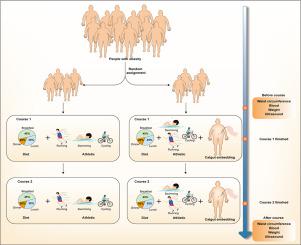European Journal of Integrative Medicine ( IF 1.9 ) Pub Date : 2023-12-17 , DOI: 10.1016/j.eujim.2023.102327 Qingqing Zhu , Jian Cheng , Xiaolan Xu , Tangying Xu , Xingjiang Gu , Yun Xia , Lingzhen Mao , Nannan Hu , Yuexia Fang

|
Introduction
Globally, the incidence of obesity is increasing, causing increased rates of hypertension, diabetes, and cardiovascular diseases. Acupoint catgut embedding, a popular acupuncture method in China, has greater efficacy than acupuncture for weight control. The effectiveness of catgut embedding in patients with fatty liver associated with metabolic dysfunction was investigated.
Methods
In this randomised controlled trial, 60 patients with gastrointestinal internal heat-type obesity were randomised to the intervention (n = 30) and control (n = 30) groups. The intervention group participated in the catgut embeddings with diet and exercise for 2 months, with a catgut treatment frequency of once every 10 days for 30 minutes. The control group participated only in diet and exercise for the same period. Body weight; body mass index (BMI); waist-to-hip ratio (WHR); fasting plasma glucose, 2-hour blood glucose, glycated haemoglobin, and lipid levels were assessed before and after treatments.
Results
Fifty-seven patients completed the courses. After 2 months, the intervention group showed a statistically significant trend of decrease in WHR and total score of gastrointestinal internal heat-type clinical symptoms when compared with the control group (mean difference: −0.03, 95% confidence level [CI]: −0.07 to 0.00 and mean difference: −6.04, 95% CI: −8.59 to −3.50, respectively). In the intervention group, the mean reductions in body weight and BMI were 6.18 kg (95% CI: 4.60 to 7.76) and 2.23 kg/m2 (95% CI: 1.72 to 2.74), respectively. The total treatment efficiency for fatty liver in the intervention and control groups was 61.5% and 30.8%, respectively (risk ratio: 3.60; 95% CI: 1.14 to 11.35).
Conclusion
Catgut embedding administered with diet and exercise is effective for patients with gastrointestinal internal heat-type obesity and some patients with obesity complicated by metabolic dysfunction-associated fatty liver disease. The effects observed in the intervention group were superior to those in the control group in terms of body weight, BMI, WHR, total score of gastrointestinal internal heat-type clinical symptoms, and treatment effectiveness for metabolic dysfunction-associated fatty liver disease. There were no serious adverse reactions during the treatment.
Registration number
ChiCTR2200057237.
Funding
This study was supported by the Hangzhou Medicine and Health Science and Technology Program and Hangzhou Lin'an District Hospital of Traditional Chinese Medicine.











































 京公网安备 11010802027423号
京公网安备 11010802027423号